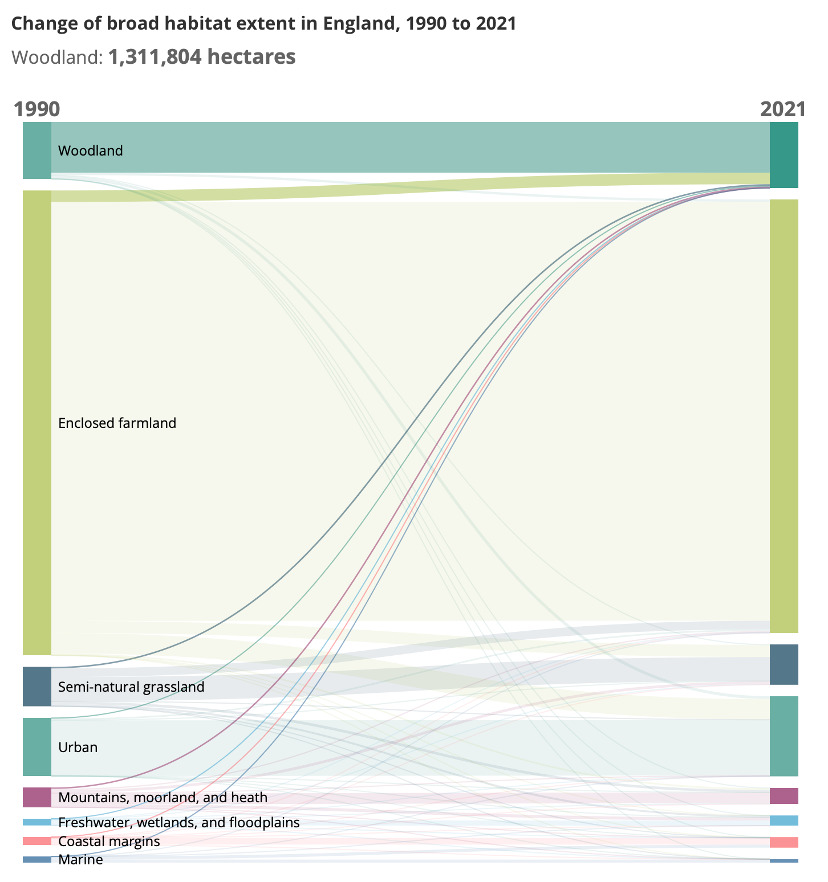Maybe some Earth Day soon, we’ll know what nature is worth

Overview
This past January, the Biden administration unveiled its “National Strategy to Develop Statistics for Environmental-Economic Decisions,” an effort to bring the health and sustainability of natural resources in the United States into the broader system of national accounting. This is not without precedent. Some nations already produce these kinds of accounts, generally using guidelines produced by the United Nations. Ultimately, the goal is to supplement well-known national accounts metrics, such as Gross Domestic Product, with data that reflects the economic costs of depleting natural resources.
When trees are cut down to create some final product—think paper or furniture—this activity is recorded in GDP as an addition to national income. A product was created and sold, adding value to the economy. But a natural resource was depleted, and services provided by that natural resource were similarly depleted, including improved air quality, recreation for campers, and runoff reduction. Gross Domestic Product does not account for these losses.
Ultimately, the pursuit of higher GDP growth without regard for the costs of environmental harm could make current levels of GDP unsustainable as the resources that once powered growth dry up. This is hardly a hypothetical scenario: the collapse of fish stocks in U.S. waters sometimes wipes out entire industries.
Environmental-economic accounts aim to provide policymakers with the information they need to manage both the growth of the economy and the future sustainability of the economy. Policy choices about the use of natural resources involve complicated tradeoffs, and the accounts will help policymakers understand those tradeoffs better. For instance, it might help decide whether designating a forest as a protected area will provide health and recreational benefits that outweigh the benefits of opening that same land to resource extraction.
In this issue brief, I give a non-technical introduction to environmental-economic accounting and review some of the Biden administration’s recommendations for implementation.
What are environmental accounts? What do they look like?
Thanks in large part to the UN’s System of Environmental Economic Accounting framework, some nations are already publishing sophisticated environmental economic accounts. The best way to understand what the Biden administration is trying to achieve is to look at some of the existing examples.
Perhaps the simplest kinds of accounts to understand are those that track the physical stocks and flows—economic jargon for change in a stock—of natural resources in a country. The United Kingdom’s Office for National Statistics, for example, tracks the total land area of various kinds of habitats, such as mountains, woodlands, farmland, and so on. These natural resource accounts enable measurements such as how the area of each of these ecosystems changed in England between 1990 and 2021. (See Figure 1.)
Figure 1
Natural resource accounts in the UK track how land use changes over time
Changes in the broad habitat of England, 1990–2021*

* The height of each bar represents the total land area of the ecosystem, and the paths between ecosystems between the two years show how land use shifted. The data is for England, which is part of the United Kingdom alongside Scotland, Wales, and Northern Ireland.
Woodlands in England, for example, increased from 1,133,411 hectares in 1990 to 1,311,804 hectares in 2021. The largest part of that expansion, about 230,000 hectares, came from the conversion of enclosed farmland to woodlands.
The United Kingdom additionally publishes several accounts that record the amount of extraction of various natural resources in a year. Its natural capital accounts from 2022, for example, reports that across the UK in 2020 about 1.2 million tons of fish were captured, 21 million people engaged in enough recreation in nature to realize significant health benefits, and about 65,000 gigawatt hours of electricity were produced by wind power, up from 946 gigawatt hours in 2000.
The intent of accounts that track the existing stock of natural assets and the annual flows is simple enough. They provide concrete metrics for assessing what resources a nation holds, and whether those stocks are increasing or declining. But what most people want out of environmental-economic accounts isn’t simply accounting for the number of people who spent some time exercising in nature. Rather, they want to know the value of services such as recreation to the economy. For that, national accountants must find ways to put a monetary value on the various services that ecosystems provide.
Valuing ecosystem services
Properly accounting for all the economic benefits of an ecosystem—each of which economists refer to as an “ecosystem service”—is a daunting task. A forest provides timber, and by observing the aggregate sales of products made from that timber, it is simple to value this ecosystem service. In fact, this kind of service is already included in GDP, since the value of trees cut down for timber is reflected in the final sales cost of products made from that timber. In these cases, environmental accounts serve primarily to make these natural contributions more visible and bring them onto the balance sheet.
But in addition to the provision of timber, there are dozens of other services the forest provides that matter. Trees remove and sequester carbon from the air, prevent runoff that damages water quality, provide recreation for campers and tourists, and more. The task of environmental accounting is to find ways to value these services so they can be considered in policy alongside other economic activities.
Economists have a number of clever ways to do just that. The Biden administration’s national strategy report gives one example. Suppose a naturally formed sand dune protects houses and other buildings in a waterfront community from flooding. This dune currently is not valued by the national accounts. But the dune’s existence will be acknowledged by insurers, who will charge lower premiums in areas that are less likely to flood. Additionally, home prices in the area may be higher than in a neighboring area that is not similarly protected. Comparison of these values allows economists to estimate the value of the service supplied by the sand dune.
Some of these techniques for valuing ecosystem services remain a point of contention between environmental economists and national accountants. The appropriate way to adjudicate these disputes is to start putting the accounts into practice. Given resources, national accountants should be able to find suitable methods for navigating these disputes. National accountants object to some common features from valuation in the environmental economics literature, such as the inclusion of consumer surplus, which is incongruent with traditional national accounting. But as some researchers have pointed out, techniques from environmental accounting provide a useful starting point for estimating accounting values.
It can be dizzying to think about all the ways humans are dependent on these ecosystems. The removal of pollution from the air by plants has far-ranging impacts on human health, such as reducing the severity of asthma, which costs the U.S. economy billions of dollars every year. In some instances, values of an ecosystem service may change significantly as researchers learn more about their benefits. The U.K.’s accounts, for example, value urban cooling.
In the United States, recent research by Equitable Growth grantee R. Jisung Park finds that excessive heat is responsible for an increase in U.S. workplace injuries—even for jobs performed indoors—and learning loss among U.S. school-age children. These findings indicate that the value of cooling may be much greater than economists would have guessed just five years ago.
The Biden administration’s handbook for establishing these accounts recommends that agencies use “the best available economic science for monetizing the value of natural assets.” The call for “best available” recognizes that valuing some ecosystem services is currently difficult, and in some cases may be impossible. It is unlikely that a system of environmental-economic accounts will be able to exhaustively document the benefits of every ecosystem.
But this is not a reason to discard environmental-economic accounts. Researchers at the Centre for Social and Economic Research on the Global Environment at the University of East Anglia perceptively note that, “in their historical evolution, national accounts have always included a degree of pragmatism. So what is included or excluded from the national accounts is to some extent a matter of choice.”
As a related example, paid child care adds to GDP, but a parent providing similar care at home does not contribute to GDP at all. Standard accounts such as GDP already make pragmatic choices based on our ability to assign values to economic activity. The environmental-economic accounts will be no different.
Communication to the public
Gross Domestic Product has proved incredibly powerful and durable among politicians, the media, and the public. It has a strong influence on economic news and is frequently invoked by candidates for office as a goal, and by sitting politicians as a mark of success. It has probably become far more influential than its creators ever anticipated.
That dominance hasn’t been entirely positive, but it’s a useful illustration of what makes a metric politically powerful. Gross Domestic Product is frequently referenced because it is:
- Released frequently, on a quarterly basis
- Released quickly, just one month after the end of the quarter it measures
- Comparable across virtually every country on Earth
Although frequently misunderstood in myriad ways, the concept is relatively simple and easy for non-specialists to understand (“making the pie bigger”).
Metrics that aim to usefully complement GDP and correct for its limitations should target some of these same features so they are adopted and used by the public. The Biden administration’s plan does an excellent job of identifying and addressing this need. The national strategy recommends a headline statistic to report to the public: change in natural asset wealth.
In other words, once dollar values are determined for the value of carbon sequestration by trees, crop pollination by bees, underground minerals, and every other quantifiable benefit of the natural world, federal economists would simply sum the change in these dollar values for the year, putting all these very different services in the form of one easy-to-understand number. Positive numbers would indicate successful stewardship of the natural world and a sustainable path of economic development.
The Biden administration further recommends annual reporting, with publication in April to coincide with Earth Day for increased media reach. Finally, the administration recommends adhering to standards in the UN’s SEEA Central Framework and Environmental Accounting frameworks to insure international alignment. These are great recommendations. National statistics aren’t solely for specialists. They should aim to inform the public about important challenges facing the nation, and it is encouraging that the administration is taking this charge seriously.
Conclusion and further reading
Although economists are still researching environmental-economic accounts, now is the right time to transition from research to practice, as many nations already have. The science of environmental-economic accounts is mature, and bringing the expertise of our national statistical agencies to bear on this new frontier will greatly hasten the development of techniques for accurately valuing natural wealth.
Some critics, including environmentalist critics, argue that putting a dollar value on nature inevitably undervalues it, and that we are better off not trying at all. The act of attempting to put an economic value on the natural world may strike some as “economism,” a somewhat pejorative term referring to the habit of economists to try to interpret everything through the lens of production and acquisition.
But like it or not, our economic statistics have an enormous impact on policy formation and public opinion. The Biden administration, and environmental policy experts, persuasively argue that valuing nature will help us conserve it.
Creating these accounts will be an enormous undertaking, requiring significant federal expenditures to develop new federal data infrastructure. The administration’s detailed plan, backed up by a strong budget request of $8 million for the U.S. Department of Commerce’s Bureau of Economic Analysis to begin implementation, demonstrates a desire to make the United States a leader in national economic statistics. Congress should support this year’s budget requests and the implementation of these accounts.
This overview is greatly indebted to a few excellent primers on environmental accounting. If you want to learn more about some of the concepts discussed here, I recommend the articles “Integrating Natural Capital into National Accounts,” and “Recording environmental assets in the national accounts.”







